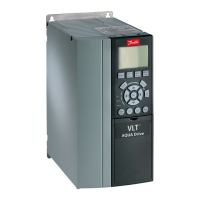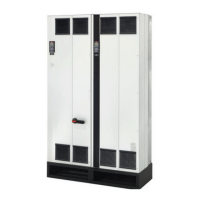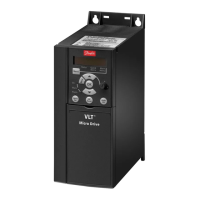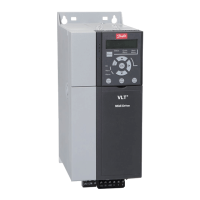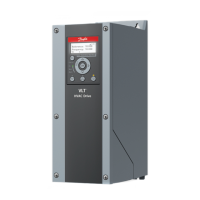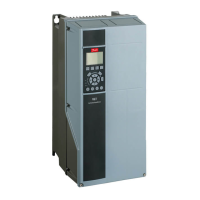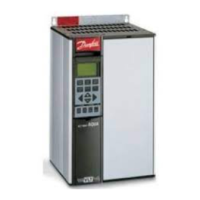Parameter 20-95 PID Dierentiation Time is set to value 0
(zero). Parameter 20-81 PID Normal/ Inverse Control is
determined during the tuning process.
These calculated values are presented in the LCP and can
be either accepted or rejected. Once accepted, the values
are written to the relevant parameters and auto-tuning
mode is disabled in parameter 20-79 Autotuning.
Depending on the system, the time required to carry out
auto-tuning could be several minutes.
Before carrying out the auto-tuning, set the following
parameters according to the load inertia:
•
Parameter 3-41 Ramp 1 Ramp Up Time.
•
Parameter 3-42 Ramp 1 Ramp Down Time.
Or
•
Parameter 3-51 Ramp 2 Ramp Up Time.
•
Parameter 3-52 Ramp 2 Ramp Down Time.
If PID auto-tuning is carried out with slow ramp times, the
auto-tuned parameters typically result in slow control.
Before activating PID auto-tuning, remove excessive
feedback sensor noise using the input lter (parameter
groups 6-** Analog In/Out, 5-5* Pulse Input and 26-** Analog
I/O Option MCB 109, parameter 6-16 Terminal 53 Filter Time
Constant, parameter 6-26 Terminal 54 Filter Time Constant,
parameter 5-54 Pulse Filter Time Constant #29,
parameter 5-59 Pulse Filter Time Constant #33). To obtain the
most accurate controller parameters, carry out PID auto-
tuning when the application runs in typical operation, that
is with a typical load.
SPC Auto-tuning
SPC initiates a tuning of DRC. If feedback from the system
determines the system to be 2
nd
order, auto-tuning
proceeds automatically with tuning of PID parameters. If
SPC discards the DRC, it is shown by the process bar going
to step 4.
DRC assumes that the frequency converter’s target
applications can be generically modeled as 1
st
order plus
dead-time systems. DRC auto-tuning is providing the
feedback for calculation.
•
τ = time constant of process system K
p
process
system gain.
•
θ = time delay between input and output DRC
can only be set up by using SPC.
20-70 Closed Loop Type
Option: Function:
Select the application response speed if it
is known. The default setting is sucient
for most applications. A more precise
value decreases the time needed for
carrying out PID adaptation. The setting
has no impact on values of parameters
and only aects the auto-tuning speed.
[0] * Auto Takes 30–120 s to complete.
20-70 Closed Loop Type
Option: Function:
[1] Fast Pressure Takes 10–60 s to complete.
[2] Slow Pressure Takes 30–120 s to complete.
[3] Fast
Temperature
Takes 10–20 minutes to complete.
[4] Slow
Temperature
Takes 30–60 minutes to complete.
20-71 Controller Performance
Option: Function:
[0] * Normal Normal setting of this parameter is suitable for
pressure control in fan systems.
[1] Fast Fast setting is used in pumping systems, where a
faster control response is wanted.
20-72 Output Change
Range: Function:
0.10* [0.01
- 0.50 ]
This parameter sets the magnitude of step
change during auto-tuning. The value is a
percentage of full speed. That is, if maximum
output frequency in parameter 4-13 Motor Speed
High Limit [RPM]/parameter 4-14 Motor Speed High
Limit [Hz] is set to 50 Hz, 0.10 is 10% of 50 Hz,
which is 5 Hz. Set this parameter to a value
resulting in feedback changes of 10–20% for best
tuning accuracy.
20-73 Minimum Feedback Level
Range: Function:
-999999
ProcessCtrlUnit*
[ -999999.999 -
par. 20-74
ProcessCtrlUnit]
Enter the minimum allowable
feedback level in user units as
dened in
parameter 20-12 Reference/
Feedback Unit. If the level
drops below
parameter 20-73 Minimum
Feedback Level, auto-tuning is
aborted and an error message
appears in the LCP.
20-74 Maximum Feedback Level
Range: Function:
999999
ProcessCtrlUnit*
[ par. 20-73 -
999999.999
ProcessCtrlUnit]
Enter the maximum allowable
feedback level in user units as
dened in
parameter 20-12 Reference/
Feedback Unit. If the level
rises above
parameter 20-74 Maximum
Feedback Level, auto-tuning is
aborted and an error message
appears in the LCP.
Parameter Description
VLT
®
AQUA Drive FC 202
166 Danfoss A/S © 05/2018 All rights reserved. MG20OB02
33
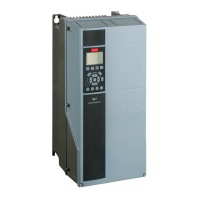
